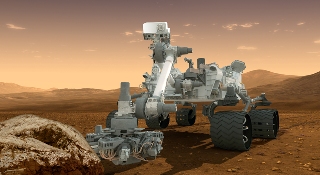Oct 3 2014
In collaboration with NASA's Jet Propulsion Laboratory in Pasadena, California, Pacific Gas and Electric Company (PG&E) announced that it is testing state-of-the-art technology adapted from NASA's Mars rover program.
 This artist's concept features NASA's Mars Science Laboratory Curiosity rover, a mobile robot for investigating Mars' past or present ability to sustain microbial life. (Image credit: NASA/JPL-Caltech)
This artist's concept features NASA's Mars Science Laboratory Curiosity rover, a mobile robot for investigating Mars' past or present ability to sustain microbial life. (Image credit: NASA/JPL-Caltech)
Originally designed to find methane on the Red Planet, this laser-based technology is lightweight and has superior sensitivity to methane, a major component of natural gas. The technology applied back on Earth helps guide PG&E crews using a tablet interface to identify possible leak locations, fast-tracking their ability to repair gas leaks.
"Our pursuit of this technology is evidence of our commitment to our mission of becoming the safest, most reliable utility in the country. We are using out-of-this-world technology to find and fix even the smallest leaks in our system. By investing in innovation today, we are helping build a positive energy future," said Nick Stavropoulos, PG&E's executive vice president of gas operations.
On Sept. 29, a new law, SB 1371, required the California Public Utilities Commission (CPUC) to open a proceeding to adopt rules and procedures that minimize natural gas leaks from gas pipelines, with the goal of reducing emissions of greenhouse gases, such as methane.
The hand-held device is the latest piece of advanced leak detection technology being embraced by the utility and is expected to be available for use in 2015. The development of this tool is part of a collaborative research effort at Pipeline Research Council International (PRCI).
"It's rewarding to be involved in projects that translate JPL technological capabilities to meet industry needs, technologies which ultimately should help enhance safety and reliability. PG&E's role as a collaborator with JPL on our PRCI-funded effort is essential to efficiently adapt the JPL methane sensor into a field-ready hand-held leak detection system," said Andrew Aubrey, JPL technologist.